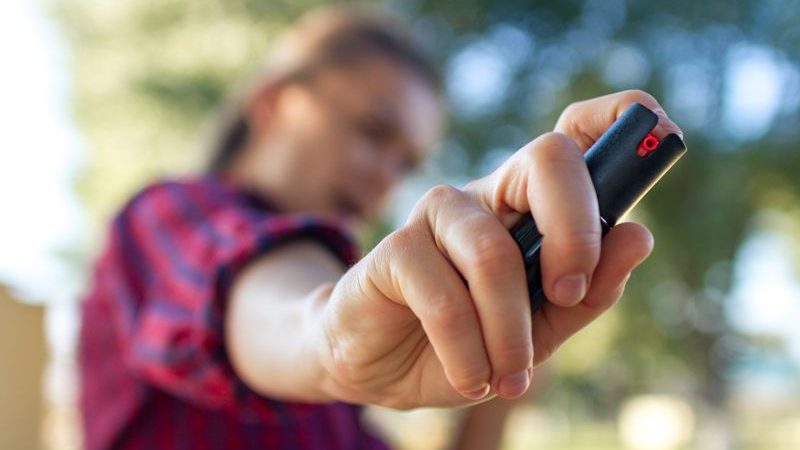
We live in a world of “better safe than sorry,” and while that saying applies to various circumstances, personal safety is most definitely one of them. Whether you’re a young female navigating a college campus, or a senior citizen enjoying fresh air on a daily walk, it’s smart to have some form of protection within reach at all times.
The type of protection you choose is a personal decision based on comfort, with options ranging from mace or a personal safety alarm to a lethal firearm. When choosing a personal safety device for both protection and peace of mind, consider the pros and cons of each.
Keys
In the absence of an actual personal safety device, many people instinctively reach for their keys. By placing a key facing outward between two fingers, it can become a makeshift weapon that can inflict minor injury and distract an assailant long enough to get away.
Pros:
- Always in your possession when away from home
- Easy to walk with a key unnoticeably positioned between your fingers
Cons:
- Not easily accessible if left in a purse or bag
- High probability of not making contact with assailant due to small size

Mace/Pepper Spray
Perhaps the most common form of personal protection, pepper spray temporarily stuns an attacker by creating a burning sensation in their eyes, nose, mouth and throat and providing plenty of time to get away safely. It typically comes in canister form in various sizes, shapes, and potency. Creative manufacturers have even introduced concealed mace in the form of lipstick, pens, and bracelets. Certain types of pepper spray even come with UV dye so your attacker can be identified.
Pros:
- Easily accessible when attached to a keychain, purse, or backpack
- Easy to use with quick disbursement of pepper spray
- Stuns assailant to the point of providing ample time to flee
- Can be used from a distance of up to 10 feet away
Cons:
- Spray requires 3-5 seconds of direct eye contact in order to be effective
- Wind can affect the trajectory of the spray, while rain can reduce effectiveness
- Losses potency over time
- Can be grabbed by assailant and used against you
- Unintentional discharge
Taser/Stun Gun
Tasers and stun guns leverage an electrical current to shock another person, making these devices very effective for personal protection. However, there is a significant difference between the two. A taser requires that you’re within arm’s reach of your attacker with the charge applied for a few seconds, while a stun gun has a shooting range of up to 15 feet.
Pros:
- Highly-effective in physically subduing an attacker
- Attack can be de-escalating at the mere sight of a taser or stun gun
Cons:
- Stun gun parts need to be replaced after each use
- Can be grabbed by assailant and used against you
- Tasers requires close proximity while stun guns require good aim
- Improper usage can lead to death, especially if used against someone with a cardiac condition

Personal Safety Alarm
Personal safety alarms like Hootie are becoming increasingly popular since they not only distract a potential assailant to provide getaway time, but also attract attention with a blaring 130-decibel alarm and hard-to-miss strobe light. Innovative companies like Hootie have made personal safety alarms not only highly-effective, but designed as must-have accessories for purses, water bottles, backpacks and more.
Pros:
- Requires no contact with potential assailant
- Can be easily engaged with the simple pull of a pin
- Can be heard up to 1,000 feet away
- Battery lasts up to one year
- Water-resistant
- Easily accessible with carabiner to a purse, backpack or water bottle
- Fits in a pocket
- Made from ultra-durable plastic
Cons:
- Does not physically harm potential attacker to subdue them
Firearm
The only lethal personal safety device on our list, a firearm is highly-effective but should be reserved for only the most dangerous of situations. As the most intimidating personal safety tool, the sight of a gun is often enough to make an attacker back away and run in the opposite direction. Many people own a gun exclusively to protect in the event of a home invasion, and choose another form of personal safety when away from home. If you choose to carry a gun, check your state laws regarding a concealed carry permit.
Pros:
- Highly-effective if lethal force is required
- Can deter or de-escalate an attack without firing
Cons:
- Accidental discharge in a non-threatening environment
- Requires training
- Requires license/permit
- Easy to miss target in a tense, stressful situation
Conclusion
When considering which personal safety device is best for your needs, consider your daily routines and most common environments. While a gun or taser might be suitable if frequenting dangerous areas, a personal safety alarm might be the more sensible option for those on college campuses or going for a daily run. Also take into consideration your level of comfort. For example, if you’re uncomfortable using a taser, chances are you’ll hesitate to reach for it when needed.
